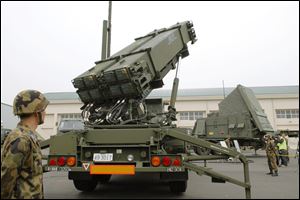
NATO: Turkey wants use of Patriot missiles
Country wants to bolster defenses along Syrian border
11/21/2012
Turkey wants to use the Patriot surface-to-air missile defense system, seen here in Japan, to protect it self from Syria.
BRUSSELS — Turkey's government requested the deployment of NATO's Patriot surface-to-air missiles today to bolster its defenses along its border with Syria and prevent a spillover of the civil war in that nation, officials said.
NATO doesn't want to be drawn into the Syrian conflict and said it would consider deploying the missiles purely to protect Turkey, a member country. Any deployment of NATO forces needs the approval of the alliance's governing body, the North Atlantic Council. But this is seen as a formality since NATO has already said it has plans in place to protect Turkey from a spillover of Syria's civil war.
“Allies will discuss this without delay,” NATO Secretary-General Anders Fogh Rasmussen said on Twitter. In a separate statement, he said the deployment would augment alliance member Turkey's air defense capabilities and “would contribute to the de-escalation of the crisis along NATO's southeastern border.”
The ambassadors of the 28 member states that make up the top council were expected to hold initial informal consultations later today.
Fogh Rasmussen said a joint team would visit Turkey next week to conduct a site survey for the possible deployment of the U.S.-built Patriots. He also noted that the deployment would not mean imposing a no-fly zone over Syrian territory, a key demand of Syrian opposition groups.
NATO allies installed the long-range Patriot batteries on Turkish territory twice before, during the 1991 and 2003 Iraq wars. They were never used and were quietly withdrawn a few months later.
In Ankara, Turkey's government said in a statement that “in face of the threats and risks posed to our national security by the ongoing crisis in Syria ... it has been decided to formally request from NATO that our national air defense be reinforced with the support of allied air defense elements.”
German Foreign Minister Guido Westerwelle said he had told the German ambassador to Turkey “to receive positively such a request.” Westerwelle says “it would be a serious mistake if we were to refuse defensive support to a NATO member country in a moment when this member country feels that it is exposed to attacks from outside.”
Within the alliance, only the United States, Germany and the Netherlands have Patriots in their arsenals. Fogh Rasmussen said it was up to those governments to decide if they can provide them to be stationed in Turkey and for how long.
On June 22, Syrian forces brought down a Turkish reconnaissance plane that further increased tensions between the neighbors. Turkey said the plane was targeted in international airspace, but Syria insisted it was flying over its territory.
Turkey has also been retaliating to shelling and mortar rounds from Syria that have landed on its territory since Oct. 3, when shells from Syria struck a Turkish village near the Syrian border, killing two women and three children. The incident prompted Turkey to convene an emergency NATO meeting and to send tanks and anti-aircraft batteries to the area.
After that, Turkey threatened to shoot down Syrian military “elements” approaching its border and began scrambling fighter jets after Syrian helicopters flew close to the frontier.
Turkey's air defenses consist mostly of short-range Rapier and Stinger systems, and U.S.-made Hawk low to medium altitude missiles. Ankara has been looking to acquire a new high-altitude defense system to replace its Cold War-era Nike-Hercules batteries.
The Patriot, which first entered service three decades ago, has been successively upgraded over the years. Although optimized for anti-aircraft defense, advanced versions can also be used against cruise missiles and against medium- and short-range ballistic missiles. They have a maximum range of about 100 miles and can reach altitudes of about 80,000 feet.